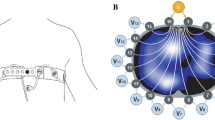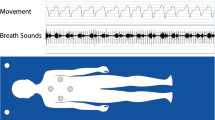Abstract
Objective
This study aims to investigate the impact of upper airway obstruction (UAO) in children by measuring thoracoabdominal asynchrony (TAA) during periods of sleep apnea/hypopnea and during scored-event-free (SEF) breathing periods.
Methods
Respiratory inductive plethysmographic signals were extracted from polysomnographic data, recorded before and after adenotonsillectomy in 40 children with UAO and 40 healthy, matched children at equivalent time points. Thoracoabdominal asynchrony was computed using a Hilbert transform-based phase difference estimation method in SEF periods during stage 2, stage 4 non-rapid eye movement (NREM), and rapid eye movement (REM) sleep and compared between the groups.
Results
At baseline, in the UAO group, TAA during obstructions were significantly higher than TAA during SEF periods in both stage 2 and REM sleep. Compared to controls, children with UAO had a significantly higher TAA during SEF periods in stage 2, stage 4 sleep, and REM sleep. This between-group difference was not significant post adenotonsillectomy. UAO group showed a significant decrease in TAA compared to their baseline during SEF stage 2 and 4 NREM, but not in REM.
Conclusion
Upper airway obstruction in children is associated with increased TAA during SEF periods, indicative of continuous partial obstruction of the upper airway. Adenotonsillectomy decreased this effect significantly in non-REM sleep as evidenced by reduced asynchrony levels post-surgery. TAA assessment during sleep may therefore provide additional diagnostic information.

Similar content being viewed by others
References
Verschakelen JA, Demedts MG (1995) Normal thoracoabdominal motions. Influence of sex, age, posture, and breath size. Am J Respir Crit Care Med 151:399–405
Hudgel DW, Martin RJ, Johnson B, Hill P (1984) Mechanics of the respiratory system and breathing pattern during sleep in normal humans. J Appl Physiol 56:133–137
Romei M, Mauro AL, D’Angelo M, Turconi A, Bresolin N, Pedotti A, Aliverti A (2010) Effects of gender and posture on thoraco-abdominal kinematics during quiet breathing in healthy adults. Resp Physiol Neurobi 172:184–191
Gaultier C, Praud J, Canet E, Delaperche M, d'Allest A (1987) Paradoxical inward rib cage motion during rapid eye movement sleep in infants and young children. J Dev Physiol 9:391–397
Kohyama J, Shiiki T, Shimohira M, Hasegawa T (2001) Asynchronous breathing during sleep. Arch Dis Child 84:174–177
Sivan Y, Deakers TW, Newth CJL (1990) Thoracoabdominal asynchrony in acute upper airway obstruction in small children. Am J Respir Crit Care Med 142:540–544
Ng D, Chan C, Chow A, Chow P, Kwok K (2005) Childhood sleep‐disordered breathing and its implications for cardiac and vascular diseases. J Paediatr Child Health 41:640–646
Owens JA (2009) Neurocognitive and behavioral impact of sleep disordered breathing in children. Pediatr Pulm 44:417–422
Marcus CL, McColley SA, Carroll JL, Loughlin GM, Smith PL, Schwartz AR (1994) Upper airway collapsibility in children with obstructive sleep apnea syndrome. J Appl Physiol 77:918–924
Arens R, McDonough JM, Costarino AT, Mahboubi S, Tayag-Kier CE, Maislin G, Schwab RJ, Pack AI (2001) Magnetic resonance imaging of the upper airway structure of children with obstructive sleep apnea syndrome. Am J Respir Crit Care Med 164:698–703
Sivan Y, Ward SD, Deakers T, Keens TG, Newth CJL (1991) Rib cage to abdominal asynchrony in children undergoing polygraphic sleep studies. Pediatr Pulm 11:141–146
Iber C, Ancoli-Israel S, Chesson AL, Quan SF (2007) The AASM manual for the scoring of sleep and associated events: rules, terminology and technical specifications. American Academy of Sleep Medicine, Westchster, IL
Rosen CL, D'andrea L, Haddad GG (1992) Adult criteria for obstructive sleep apnea do not identify children with serious obstruction. Am J Respir Crit Care Med 146:1231–1234
Marcus CL (2001) Sleep-disordered breathing in children. Am J Respir Crit Care Med 164:16–30
American Thoracic Society (1996) Standards and indications for cardiopulmonary sleep studies in children. Am J Respir Crit Care Med 153:866–878
Gozal D, Kheirandish-Gozal L (2010) New approaches to the diagnosis of sleep-disordered breathing in children. Sleep Med 11:708–713
Bandla HP, Gozal D (2000) Dynamic changes in EEG spectra during obstructive apnea in children. Pediatr Pulm 29:359–365
Foo JYA, Wilson SJ, Bradley AP, Williams GR, Harris M-A, Cooper DM (2005) Use of pulse transit time to distinguish respiratory events from tidal breathing in sleeping children. Chest 128:3013–3019
Rosenblum M, Kurths J (1998) Analysing synchronization phenomena from bivariate data by means of the Hilbert transform. Nonlinear analysis of physiological data Springer, In, p 91p
Immanuel SA, Pamula Y, Kohler M, Martin J, Kennedy D, Kabir MM, Saint DA, Baumert M (2012) Respiratory timing and variability during sleep in children with sleep-disordered breathing. J Appl Physiol 113:1635–1642
Rechtschaffen A, Kales A (1968) A manual of standardized terminology, techniques and scoring system for sleep stages of human subjects.
Kuczmarski RJ, Ogden CL, Grummer-Strawn LM, Flegal KM, Guo SS, Wei R, Mei Z, Curtin LR, Roche AF, Johnson CL (2000) CDC growth charts: United States. Adv Data 314:1–27
Schneider R, Bauer A, Barthel P, Schmidt G (2004) libRASCH—a programming framework for transparent access to physiological signals. Conf Proc IEEE Eng Med Biol Soc 2:3254–3257
Tabachnik E, Muller NL, Bryan AC, Levison H (1981) Changes in ventilation and chest wall mechanics during sleep in normal adolescents. J Appl Physiol 51:557–564
Henke K, Badr M, Skatrud J, Dempsey J (1992) Load compensation and respiratory muscle function during sleep. J Appl Physiol 72:1221–1234
Tusiewicz K, Moldofsky H, Bryan A, Bryan M (1977) Mechanics of the rib cage and diaphragm during sleep. J Appl Physiol 43:600–602
Bower CM, Gungor A (2000) Pediatric obstructive sleep apnea syndrome. Otolaryng Clin Nam 33:49–75
Isono S, Shimada A, Utsugi M, Konno A, Nishino T (1998) Comparison of static mechanical properties of the passive pharynx between normal children and children with sleep-disordered breathing. Am J Respir Crit Care Med 157:1204–1212
Marcus CL, Katz ES, Lutz J, Black CA, Galster P, Carson KA (2005) Upper airway dynamic responses in children with the obstructive sleep apnea syndrome. Pediatr Res 57:99–107
Brouillette RT, Fernbach SK, Hunt CE (1982) Obstructive sleep apnea in infants and children. J Pediatr 100:31–40
Acknowledgments
MB holds a fellowship from the Australian Research Council, and this project was partly supported by grant ARC DP 110102049, DP 0663345, and NH&MRC project grant 250369.
Conflict of interest
The authors declare that they have no conflict of interest.
Author information
Authors and Affiliations
Corresponding author
Rights and permissions
About this article
Cite this article
Immanuel, S.A., Kohler, M., Martin, J. et al. Increased thoracoabdominal asynchrony during breathing periods free of discretely scored obstructive events in children with upper airway obstruction. Sleep Breath 19, 65–71 (2015). https://doi.org/10.1007/s11325-014-0963-3
Received:
Revised:
Accepted:
Published:
Issue Date:
DOI: https://doi.org/10.1007/s11325-014-0963-3




